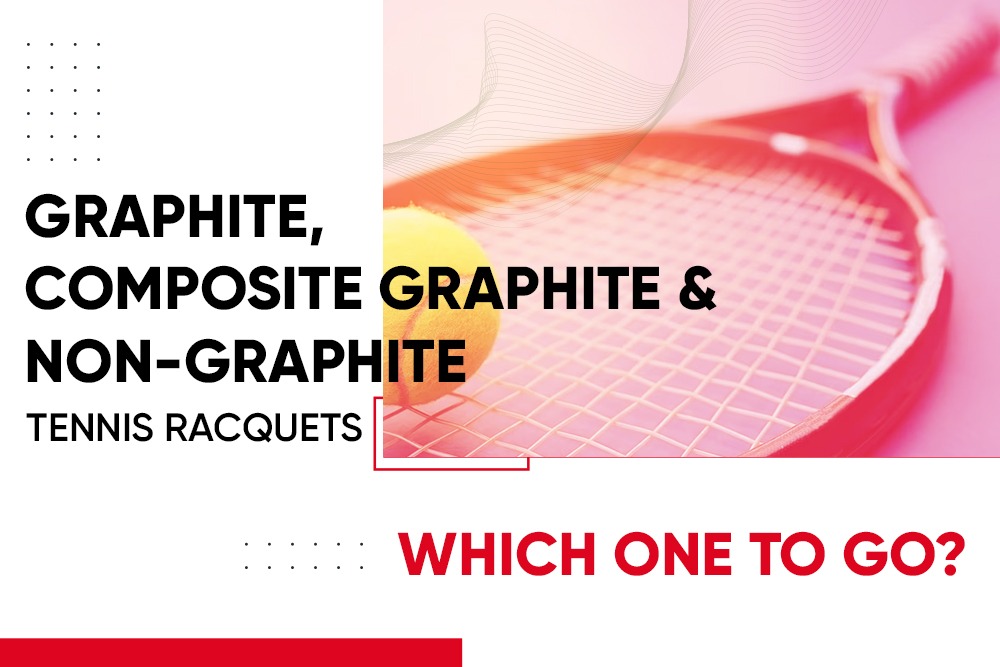From our expert queries, we are frequently asked what a good racquet is. Should I buy a cheap or more expensive racquet? We consider it a valid question and we would like to brief you about the racquet types and which one to go according to your requirements. Technically, three types of racquets are available in the current market. Graphite, Composite Graphite and Entry-Level racquets. All three differ in their construction materials and properties. Graphite tennis racquets are made primarily of graphite fibers, which are known for their strength, stiffness, and lightness. These racquets are popular among advanced and professional players because they offer more control, precision, and power. Graphite racquets are also more expensive than other types of racquets due to the higher cost of the materials used in their construction.
Composite graphite tennis racquets are made of a combination of graphite fibers and other materials, such as fiberglass or Kevlar. These racquets are designed to offer a balance of strength, stiffness, and lightness while providing a larger sweet spot than pure graphite racquets. Composite graphite racquets are generally less expensive than pure graphite racquets, making them a popular choice among intermediate players. Entry-Level tennis racquets are typically made of materials such as aluminum, titanium, or composites. These racquets are generally less expensive than graphite or composite graphite racquets and are a good choice for beginners and recreational players.
Below mentioned the parameters you can consider before buying a tennis racquet.
-
The material composition of the racquet:
Our advice would be to buy a single-piece racquet (Graphite). A single-piece racquet is one unit, it can transmit your power from your swing into the ball more effectively than a racquet with two pieces. Two-piece racquets are fine for juniors but adults will lose some of their racquet head speed playing with a two-piece one. The racquet is more likely to twist in your hand when you hit a hard ball.The very best racquets are made of high-grade graphite. These are stiff to absorb the vibrations from the racquet and will transfer your swing to the tennis ball. Non-Graphite racquets are usually made of aluminum or alloy. They are light and certainly don’t perform as well as the high-end racquets. Even mid-price range composite graphite frames have the characteristics of a high-end frame but cannot offer the same consistent power over a long period. Although non-graphite and composite graphite racquets can be restrung they would typically not be as strong as a graphite racquet meaning after a broken string they may not last as long.
-
Weight of the racquet:
It is recommended that beginner players start with a lightweight racquet so that it is easy for them to maneuver the racquet and learn the technique easily. It is a myth that only Non-Graphite racquets are lighter to swing and generate power than graphite racquets. It is no doubt to swing easier but Graphite racquets offer more power. Even in the top-end racquets, brands offer light and maneuverable frames of around 250-270 grams as well. More skilled players prefer smaller head-sized heavy racquets to play more precise and accurate shots. But the same racquet will be extremely difficult for a beginner to play with. - Head size of the racquet:
We recommend beginners go with a bigger head size (102-105sq.inches) as they offer more sweet spot and makes it easier to hit the ball effectively. Professional players prefer a 90-97sq.inch racquets. Sweet spots on such racquets are quite small and require an enormous amount of precision and accuracy to hit the ball. In the modern game, the most popular sizes at the moment are around 100sq.inch. These racquets have ample sweet spots and are not far from maneuvering the racquet easily.
Again, it is a personal choice fundamentally based on what is going to be good for your game.
In summary, graphite tennis racquets offer the best performance and are preferred by advanced and professional players. Composite graphite racquets offer a balance of performance and affordability and are popular among intermediate players. Non-graphite racquets are a good choice for beginners or casual players who prioritize affordability.













Comments